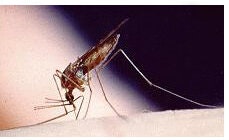Malaria
Malaria was introduced in the central valley of California in the 1800's. Many mosquito control districts were formed primarily to combat the disease thru controlling the Anopheles freeborni mosquito. Butte County Mosquito and Vector Control District was formed in 1948 to combat malaria. The combination of case recognition, treatment and successful mosquito abatement essentially eliminated malaria as a major health concern in the early 1900's. However, persistent Anopheline abundance and repeated importation of malaria in infected immigrants and travelers poses a risk of transmission and re-establishment in our agricultural based, mosquito-friendly central valley.

Malaria transmission begins when parasites present in the bloodstream of a malaria infected human are ingested with the bloodmeal of a female Anopheles mosquito. These parasites then burrow through the mosquito's gut wall. Outside of the gut, they multiply for 8 - 14 days, after which they migrate to the mosquito's salivary gland. They remain there until the mosquito takes her next bloodmeal. The parasites are transmitted to the next human in the small amount of salivary fluid secreted by the mosquito when feeding. After being transmitted into the bloodstream, the parasites travel to the liver, multiply, and then move out to attack red blood cells. Later during the infection the parasites become abundant enough to be picked up by another Anopheles mosquito during a bloodmeal. There are 4 different parasites that cause disease. The most serious is called Plasmodium falciparium, which can cause severe anemia, kidney failure, brain damage and death.
